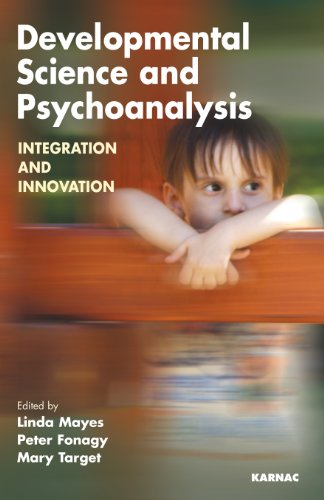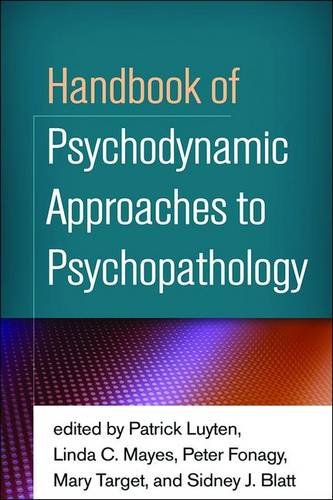Developmental Science and Psychoanalysis: Integration and Innovation
Linda Mayes
This volume marks the renewal of a past tie between two institutions historically dedicated to the well-being of children and their families - the Anna Freud Centre in London and the Yale Child Study Center. The papers and discussions in this volume are from scholars in both the UK and the United States whose work is relevant to developmental psychoanalysis. As a discipline, psychoanalysis began at the interface of mind and brain and has always been about those most basic questions of biology and psychology - loving, hating, what brings us together as lovers, parents, and friends and what pulls us apart in conflict and hatred. These are the enduring mysteries of life and especially of early development - how young children learn the language of the social world with its intertwined biological, genetic, and experiential roots and how infants translate thousands of intimate moments with their parents into a genuine, intuitive, emotional connection to other persons. Basic developmental neuroscience and psychology has also of late turned to these basic questions of how it is as humans our most basic concerns are about finding, establishing, preserving, and mourning our relationships. These are key areas to understanding our capacities for resilience across life or our vulnerability to life's hardships. These areas in broad strokes are also the substance of mind and brain and the last decade has brought much new science to the biology of attachment, love, and aggression. These are areas that practicing psychoanalysts have long been immersed in and have much to say about and contemporary neuroscientists and developmentalists are recognizing the importance of understanding these basic issues at a deeper, and more subjective experiential level.
The papers in this volume show how psychoanalysts and developmental cognitive and neuroscientists come together to address these most basic mind-brain, body and mind issues with shared perspectives. Ami Klin and his young colleague bring developmental cognitive science to the basic psychoanalytic observation that the mind takes shape in the earliest bodily sensations of hunger, touch, hot/cold, pain, and comfort. Lane Strathearn and also James Leckman illustrate how contemporary neuroimaging brings new perspectives to key questions regarding early parent-infant attachment and begins to elucidate the neural circuitry that in a part of normal parental preoccupation regarding the infant. Gergely shows how cognitive science can contribute productive empirical perspectives to understanding how the earliest interactions between mother and baby get into the mind and brain of the infant. Solms, one of the most well known proponents of integrating neuroscience with psychoanalysis, offers an integration of the interpretation of dreams with contemporary studies of the neural function of sleep states. Other contributors including Eia Asen, Jonathan Hill, Alan Kazdin, and Robin Weersing each speak newer approaches to psychiatric treatment for adults and children that may be informed by developmental neuroscience and with their discussants, address the relationship with more traditional psychoanalytic points of view. Marans and colleagues take psychoanalytic principles into real world settings as they work with severely traumatized children and families and integrate contemporary understanding of the psychobiology of early trauma into their day to day clinical work. And attachment theory as it informs psychoanalysis is vividly discussed both by Miriam Steele in her long-term studies of adopted children and by Anthony Bateman in his work with severely personality disordered adults.
Each of the discussants for these authors brings a psychoanalytic focus to their comments and shows the possibilities of integration across fields. The challenges highlighted by this volume are how to facilitate open discourse and collaborations among these perspectives and practitioners that often work at very different levels of discourse. The themes of the papers and the pairing of discussants in this volume is a beginning illustration of how the cross-disciplinary discourse may work - and work well.
This volume marks the renewal of a past tie between two institutions historically dedicated to the well-being of children and their families - the Anna Freud Centre in London and the Yale Child Study Center. The papers and discussions in this volume are from scholars in both the UK and the United States whose work is relevant to developmental psychoanalysis. As a discipline, psychoanalysis began at the interface of mind and brain and has always been about those most basic questions of biology and psychology - loving, hating, what brings us together as lovers, parents, and friends and what pulls us apart in conflict and hatred. These are the enduring mysteries of life and especially of early development - how young children learn the language of the social world with its intertwined biological, genetic, and experiential roots and how infants translate thousands of intimate moments with their parents into a genuine, intuitive, emotional connection to other persons. Basic developmental neuroscience and psychology has also of late turned to these basic questions of how it is as humans our most basic concerns are about finding, establishing, preserving, and mourning our relationships. These are key areas to understanding our capacities for resilience across life or our vulnerability to life's hardships. These areas in broad strokes are also the substance of mind and brain and the last decade has brought much new science to the biology of attachment, love, and aggression. These are areas that practicing psychoanalysts have long been immersed in and have much to say about and contemporary neuroscientists and developmentalists are recognizing the importance of understanding these basic issues at a deeper, and more subjective experiential level.
The papers in this volume show how psychoanalysts and developmental cognitive and neuroscientists come together to address these most basic mind-brain, body and mind issues with shared perspectives. Ami Klin and his young colleague bring developmental cognitive science to the basic psychoanalytic observation that the mind takes shape in the earliest bodily sensations of hunger, touch, hot/cold, pain, and comfort. Lane Strathearn and also James Leckman illustrate how contemporary neuroimaging brings new perspectives to key questions regarding early parent-infant attachment and begins to elucidate the neural circuitry that in a part of normal parental preoccupation regarding the infant. Gergely shows how cognitive science can contribute productive empirical perspectives to understanding how the earliest interactions between mother and baby get into the mind and brain of the infant. Solms, one of the most well known proponents of integrating neuroscience with psychoanalysis, offers an integration of the interpretation of dreams with contemporary studies of the neural function of sleep states. Other contributors including Eia Asen, Jonathan Hill, Alan Kazdin, and Robin Weersing each speak newer approaches to psychiatric treatment for adults and children that may be informed by developmental neuroscience and with their discussants, address the relationship with more traditional psychoanalytic points of view. Marans and colleagues take psychoanalytic principles into real world settings as they work with severely traumatized children and families and integrate contemporary understanding of the psychobiology of early trauma into their day to day clinical work. And attachment theory as it informs psychoanalysis is vividly discussed both by Miriam Steele in her long-term studies of adopted children and by Anthony Bateman in his work with severely personality disordered adults.
Each of the discussants for these authors brings a psychoanalytic focus to their comments and shows the possibilities of integration across fields. The challenges highlighted by this volume are how to facilitate open discourse and collaborations among these perspectives and practitioners that often work at very different levels of discourse. The themes of the papers and the pairing of discussants in this volume is a beginning illustration of how the cross-disciplinary discourse may work - and work well.



